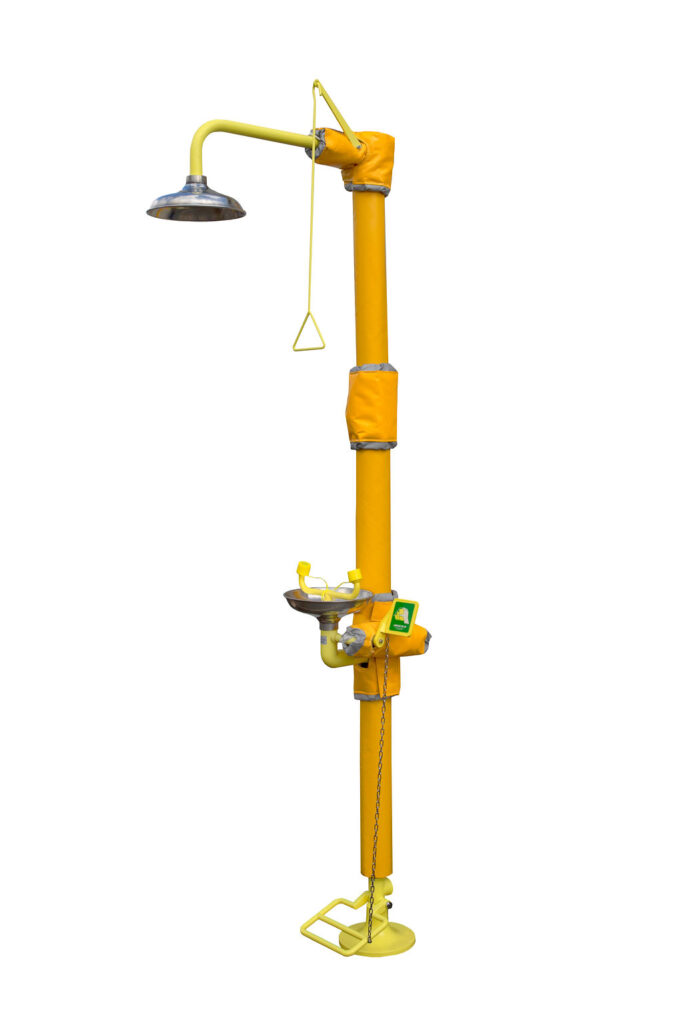Your basket is currently empty!
The Essential Guide to Emergency Showers and Eyewashes: Safety Standards and Best Practices

Wall Mounted Emergency Shower and Eyewash – The 4285.
This in-depth guide covers the vital roles of emergency showers and eyewashes in workplace safety, focusing on installation, compliance, and upkeep to protect workers from hazardous exposures.
Introduction:
In workplaces where chemicals and hazardous substances are a part of the daily operation and business, ensuring the safety and health of employees is paramount. Emergency showers and eyewashes are critical components for industrial safety measures, providing immediate decontamination to minimise injury from chemical exposures. This blog post aims to provide a thorough exploration of emergency showers and eyewashes. We’ll cover why they’re essential, what standards they need to meet, how to install them correctly, and the best practices for maintaining them. This information is vital for anyone involved in safety management or facility operations.
The Importance of Emergency Showers and Eyewashes
Exposure to hazardous chemicals can cause serious injuries or even life-threatening conditions. Emergency showers and eyewashes are designed to flush out these substances, significantly reducing the risk of long-term damage. They are an immediate first step in treating chemical burns, splashes, or other exposures, essential in environments ranging from chemical manufacturing plants to laboratories.
Flow rates for emergency showers need to be 110L/minute and eyewashes are 22L/minute. The operating pressures should be between 2bar and 8bar.
Compliance and Standards
Various international standards govern the installation and maintenance of emergency showers and eyewashes. In the United States, the American National Standards Institute (ANSI) Standard Z358.1 is particularly influential. This standard specifies minimum performance and use requirements, including the rate of water flow, the temperature of the water, and the distance from the hazard. Adhering to these standards is not just about regulatory compliance; it’s about ensuring that emergency equipment is effective when it’s needed the most. We have ANSI standards on all our safety products as well as:
Installation Best Practices
Proper installation of emergency showers and eyewashes is crucial for their effective operation. They must be accessible within 10 seconds or less from the hazard zone and located on the same level, with a clear path free of obstacles. The area around the installation must be well-lit and clearly marked. Additionally, facilities must consider the potential for freezing conditions and ensure that the water delivery system is protected against such hazards – enter the Arboles UK ‘All Weather’ (AW) options that come with trace heating and insulation jackets.

Outdoor emergency shower & eyewash with trace heating and insulating jacket for frost proof protection.
Maintenance and Testing
Regular maintenance and testing are critical to ensure that emergency showers and eyewashes will function correctly during an emergency. ANSI guidelines recommend activating these devices at least weekly to flush out the system and verify proper operation. Additionally, it’s important to conduct an annual inspection to check for compliance with all aspects of the ANSI standard, including flow rates and temperature. We supply testing cards to ensure that this can be recorded.
Training and Awareness
Training employees on how to properly use emergency showers and eyewashes is as important as having the devices installed. Workers should be aware of the locations of these devices, the situations in which they need to be used, and the steps to follow after an exposure has occurred. Regular drills and training sessions can help reinforce this knowledge and ensure quick and correct responses during an actual emergency.
Conclusion
Emergency showers and eyewashes are vital safety features in any workplace dealing with hazardous substances. By understanding the standards and best practices for their installation, maintenance, and use, organisations can significantly enhance the safety and well-being of their employees. Always remember, the goal is not just to meet legal requirements but to create a safe and responsive work environment.
